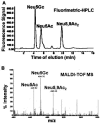Sialic acids siglec interaction: a unique strategy to circumvent innate immune response by pathogens
- PMID: 24434319
- PMCID: PMC3928697
Sialic acids siglec interaction: a unique strategy to circumvent innate immune response by pathogens
Abstract
Sialic acids (Sias) are nine-carbon keto sugars primarily present on the terminal residue of cell surface glycans. Sialic acid binding immunoglobulins (Ig)-like lectins (siglecs) are generally expressed on various immune cells. They selectively recognize different linkage-specific sialic acids and undertake a variety of cellular functions. Many pathogens either synthesize or acquire sialic acids from the host. Sialylated pathogens generally use siglecs to manipulate the host immune response. The present review mainly deals with the newly developed information regarding mechanism of acquisition of sialic acids by pathogens and their biological relevance especially in the establishment of successful infection by impairing host innate immunity. The pathogens which are unable to synthesize sialic acids might adsorb these from the host as a way to engage the inhibitory siglecs. They promote association with the immune cells through sialic acids-siglec dependent manner. Such an association plays an important role to subvert host's immunity. Detailed investigation of these pathways has been discussed in this review. Particular attention has been focused on Pseudomonas aeruginosa (PA) and Leishmania donovani.
Figures






Similar articles
-
Leishmania donovani Utilize Sialic Acids for Binding and Phagocytosis in the Macrophages through Selective Utilization of Siglecs and Impair the Innate Immune Arm.PLoS Negl Trop Dis. 2016 Aug 5;10(8):e0004904. doi: 10.1371/journal.pntd.0004904. eCollection 2016 Aug. PLoS Negl Trop Dis. 2016. PMID: 27494323 Free PMC article.
-
The Role of Sialic Acids in the Establishment of Infections by Pathogens, With Special Focus on Leishmania.Front Cell Infect Microbiol. 2021 May 13;11:671913. doi: 10.3389/fcimb.2021.671913. eCollection 2021. Front Cell Infect Microbiol. 2021. PMID: 34055669 Free PMC article. Review.
-
The interplay between Siglecs and sialylated pathogens.Glycobiology. 2014 Sep;24(9):818-25. doi: 10.1093/glycob/cwu067. Epub 2014 Jul 4. Glycobiology. 2014. PMID: 24996821 Free PMC article. Review.
-
Siglecs at the Host-Pathogen Interface.Adv Exp Med Biol. 2020;1204:197-214. doi: 10.1007/978-981-15-1580-4_8. Adv Exp Med Biol. 2020. PMID: 32152948 Free PMC article. Review.
-
Evolution of CD33-related siglecs: regulating host immune functions and escaping pathogen exploitation?Immunology. 2011 Jan;132(1):18-26. doi: 10.1111/j.1365-2567.2010.03368.x. Epub 2010 Nov 11. Immunology. 2011. PMID: 21070233 Free PMC article. Review.
Cited by
-
Identification of lipophilic ligands of Siglec5 and -14 that modulate innate immune responses.J Biol Chem. 2019 Nov 8;294(45):16776-16788. doi: 10.1074/jbc.RA119.009835. Epub 2019 Sep 24. J Biol Chem. 2019. PMID: 31551352 Free PMC article.
-
Interferon Alpha Favors Macrophage Infection by Visceral Leishmania Species Through Upregulation of Sialoadhesin Expression.Front Immunol. 2020 Jun 9;11:1113. doi: 10.3389/fimmu.2020.01113. eCollection 2020. Front Immunol. 2020. PMID: 32582193 Free PMC article.
-
Heparanase-Dependent Remodeling of Initial Lymphatic Glycocalyx Regulates Tissue-Fluid Drainage During Acute Inflammation in vivo.Front Immunol. 2019 Oct 4;10:2316. doi: 10.3389/fimmu.2019.02316. eCollection 2019. Front Immunol. 2019. PMID: 31636638 Free PMC article.
-
Molecular cloning of porcine Siglec-3, Siglec-5 and Siglec-10, and identification of Siglec-10 as an alternative receptor for porcine reproductive and respiratory syndrome virus (PRRSV).J Gen Virol. 2017 Aug;98(8):2030-2042. doi: 10.1099/jgv.0.000859. Epub 2017 Jul 26. J Gen Virol. 2017. PMID: 28742001 Free PMC article.
-
Sequence analysis of nonulosonic acid biosynthetic gene clusters in Vibrionaceae and Moritella viscosa.Sci Rep. 2020 Jul 20;10(1):11995. doi: 10.1038/s41598-020-68492-3. Sci Rep. 2020. PMID: 32686701 Free PMC article.
References
-
- Mandal C, Mandal C. Sialic acid binding lectins - a review. Experientia. 1990;46:433–41. - PubMed
-
- Sinha D, Chatterjee M, Mandal C. O-acetylation of sialic acids- their detection, biological significance and alteration in diseases- a review. Trends Glycosci Glycotechnol. 2000;12:17–33.
-
- Mandal C, Chatterjee M, Sinha D. Investigation of 9-O-Acetylated sialoglycocongugates in childhood acute lymphoblastic leukaemia. Br J Hematol. 2000;110:801–12. - PubMed
Publication types
MeSH terms
Substances
LinkOut - more resources
Full Text Sources
Medical
